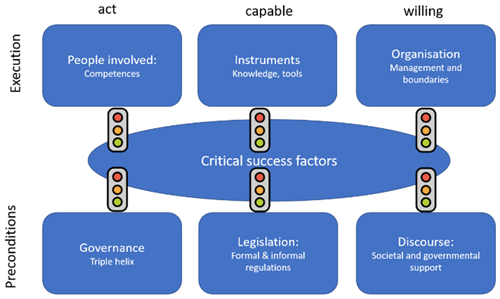the Creative Commons Attribution 4.0 License.
the Creative Commons Attribution 4.0 License.
Working Together on Civil-Engineering Structures within the Dutch Flood Protection Programme: challenges and opportunities
Joost Breedeveld
Johan Apperloo
Jaap Kottier
Over 400 civil-engineering structures (e.g. sluices, pumping stations) are listed in the Dutch Flood Protection Programme (DFPP). That is a daunting task for the next 30 years, meaning that every three weeks one structure should be reinforced to meet the statutory standards. In an innovation project, the regional water authorities, Rijkswaterstaat, the Dutch Flood Protection Programme, research institutes and the consultancy agencies joint forces. In the past period, we have identified numerous obstacles, using the critical success factors framework, that hamper the reinforcement of these civil engineering structures. To tackle the barriers, we developed a roadmap that gives more insight in the steps for strengthening these structures. In addition, lessons learned from current strengthening projects on civil engineering structures are used to further optimize the overall programming of these structures within DFPP, and to enhance the knowledge transfer and uptake within the triple helix.
- Article
(2020 KB) - Full-text XML
- BibTeX
- EndNote
Two-thirds of the Netherlands is below the current sea level, and this amount is likely to increase due to climate change. In the past, the Dutch responded reactively to floods. However, after the catastrophic floods of 1953, the Dutch took measures to prevent a similar disaster: a system of dike rings with flood protection levels was developed for flood risk management (Most et al., 2014), and statutory standards were set out in the Flood Protection Act of 1996 to maintain this system. Those standards related to the primary flood defences: those on the coast, major rivers and lakes. In 2008, the second Delta Commission advised changes to take future uncertainties, such as climate change and land subsidence, into account to sustainably protect the Netherlands. The Dutch national government adopted a risk-based approach (Most et al., 2014) for the Dutch flood risk management policy. This is based on new knowledge about the safety of dikes and the impact of serious floods because of the failure of dikes and/or other structures. This is a proactive approach, in which protection standards are based on both the probability and the impact of flooding in 2050, considering climate change and socio-economic developments. The Environment Act sets out the statutory standards for the flood protection structures, such as dikes, dams, and other civil-engineering structures (e.g. locks, coupures, siphons). Every 12 years, the regional water authorities are required to conduct assessments to ensure that the flood defences still meet the statutory standards. Where the safety standards are not met, the responsible body can apply for funding from the Dutch Flood Protection Programme (DFPP) (Jorissen et al., 2016). Over 1500 km of dikes and 400 civil-engineering structures will have to be upgraded between now and 2050.
In this paper, we focus primarily on the civil-engineering structures that often consist of a location-specific combination of components and materials and are required to perform other functions too. For these structures, multiple parties with their own individual interests and responsibilities - play a role, and they seek to minimise trade-offs. This complexity further emphasises the importance of knowledge management and continuous learning around these structures. In addition, within the DFPP programme board it is felt that these structures seem to get limited attention, whereas the investment needed to strengthen these structures to meet the statutory standards is high. The number of structures that are currently on the programme requires that every three weeks a structure is strengthened. This sense of urgency led the programme board, together with other parties, to initiate an innovation project dedicated only to these civil-engineering structures to develop instruments. This paper aims to provide an overview of current activities to gain more attention to the DFPP-listed civil-engineering structures.
The paper is structured as follows: Sect. 2 presents the methods, looking at the Dutch Flood Protection Programme and specifically to the civil-engineering structures, followed by a description of the methodology used in our study; in Sect. 3, we describe how the framework helped to identify challenges and opportunities, and how they are faced. Finally, Sect. 4 presents the discussion and conclusions of this paper.
2.1 Dutch Flood Protection Programme: context
Currently, the DFPP faces the task to upgrade about 1500 km of dikes and about 400 civil-engineering structures before 2050. The exact numbers depend on the results of the statutory assessment of flood defences by the regional water authorities; first round after the new implementation of the risk-based approach finishes in 2023. To ensure that the reinforcement task of DFPP is realized within time and available budget, they adopted a knowledge and innovation strategy. In Tromp et al. (2022b) more information is available on this learning-while-doing strategy. In 2018, representatives of Rijkswaterstaat, the regional water authorities, knowledge institutes and consultancy agencies together underline the necessity to start an innovation project focused on the civil engineering structures that are part of the primary flood defence system in the Netherlands (DFPP, 2018). This includes locks, sluices, culverts, pumping stations and storm surge barriers. The DFPP uses the definition for civil-engineering structures according to The Dutch Environment Act (2016): a construction that is part of a flood defence and, over a limited length, takes over all or part of the flood protection function of the body of land, but is constructed for the purpose of another (utilitarian) function that crosses the flood defence (such as draining and facilitating navigation). In connection with this utilitarian function, these hydraulic structures are usually equipped with one or more valves. For the DFPP, the stricter requirement is that the flow surface of the water retaining structure must be >0.5 m2 (DFPP, 2016).
In 2021, Regional water Authority Hollands Noorderkwartier initiated the innovation project “Working jointly together on Civil-engineering structures”. This specific regional water authority already had experience with strengthening structures, as they carried out a pilot where seven sluices were strengthened. Aim was to gain more insight in the current sense of urgency for the civil-engineering structures within the Dutch Flood Protection Programme. For the first phase, the core team identified four pillars: (1) Inventory on the overall reinforcement scope within DFPP, (2) Inventory on the challenges and opportunities when starting a reinforcement project, (3) Inventory on knowledge gaps around hydraulic structures, and (4) Identification of the current sense of urgency around these civil engineering structures, both at the administrative and executive level.
2.2 Methodology
The core team used the methodology and framework that was developed by the DFPP programme board, as laid down in the knowledge and innovation strategy; more specifically the insights gained on knowledge management and the critical success framework, as shown in Tromp et al. (2022b). This framework (Fig. 1) identifies six critical success factors (CSFs):
-
People involved: is sufficient knowledge and expertise available for the project team, and does the involved people have the required competences?
-
Instruments: are the knowledge and tools available to design the structures in its surroundings?
-
Organisation: is there political willingness to take risks, and what boundary conditions have been given to the project team?
-
Governance: how is decision-making organised, and how are organisations such as contractors and local stakeholders involved?
-
Legislation: how can the project comply with formal and informal regulations?
-
Discourse: is there enough support in society for strengthening the structures?
The three success factors on the lower row of Fig. 1 are preconditions located outside the boundaries of influence of flood defence reinforcement projects. The remaining three success factors can be controlled by either the regional water authorities or the project team members. The traffic lights in Fig. 1 show that if one of the CSF's is at red or orange a project stagnates in its implementation. This specific framework helps the DFPP to formulate activities to enhance, and possibly steer, the development of knowledge and innovations.
While the focus in Tromp et al. (2022b) was on an enhanced understanding of which elements of the knowledge and innovation strategy work and others fail, the focus here was on finding out why regional water authorities do have not yet undertaken water retaining structures, using the CSF framework. However, this framework has never been used from the onset of an (innovation) project to explore, for the different phases and at so many different organisations, at what factors caused, in this case the non-reinforcement of civil engineering structures within DFPP. With this approach, we illustrate how knowledge development, transfer and uptake can be enhanced by focusing on one or more CSFs in particular way.
In the next section, we describe in more detail the scope and challenges for the civil-engineering structures within the DFPP.
Within the DFPP project “Working jointly together on Civil-engineering structures”, further insight into the scope of the task, a uniform approach and available knowledge is gained. In this section we describe these results of the research.
3.1 Scope of the civil-engineering structures within DFPP
In the Netherlands a total of 1824 civil-engineering structures are in the primary flood defence system, this includes culverts, sluices, storm surge barriers, movable barriers (see Fig. 2). All regional water authorities and Rijkswaterstaat were approached to share information already available from their running statutory assessments. This was mostly mid-term information because the organisations had not all finished. By summer 2021, about 40 % had been assessed (total of 685). Of these, 547 structures were found to meet the specified lower limit of the safety requirement and 138 structures did not meet the lower limit. Of the 138 structures that failed the statutory assessment, the authorities have indicated a wish to include 91 in the DFPP. Of the other remaining structures, this was unknown.
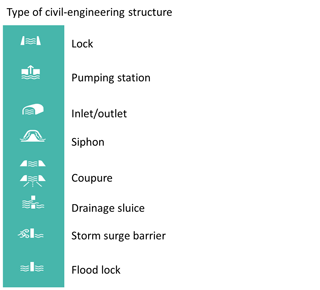
Figure 2Artists impressions of civil-engineering structures in the primary flood defence system of the Netherlands (credit: project Working jointly together on Civil-engineering structures).
Table 1Overview of civil-engineering structures that do not comply with the Dutch statutory standard.

The team (IV Infra, 2021) made an extrapolation to gain insights how many structures could potentially be on the DFFP programme. This led to the insight that approximately 370 civil-engineering structures, of which 50 large scale structures must be strengthened within the Dutch Flood Protection Programme. Most structures fail to meet two dominant safety requirements: sufficient height and a sufficiently reliable closure process; less dominant are piping and stability. In the study the team also distinguished between the different types, as shown in Table 1.
This scoping should be updated in 2024 when all the results of the statutory assessment are available. This will undoubtedly lead to changes in the overall scoping.
3.2 Uniform approach: opportunities and challenges
For the uniform approach, we have created the so-called Civil-engineering Roadmap (Fig. 3). This roadmap describes the set of steps taken during the life cycle of a Civil-engineering structure in a primary flood defence. Previous analyses and discussions revealed the need to visualise this process. The drafted roadmap distinguishes the following three steps: (1) Obligation to provide care on a daily basis, (2) Initiation; and (3) (DFPP) Project.
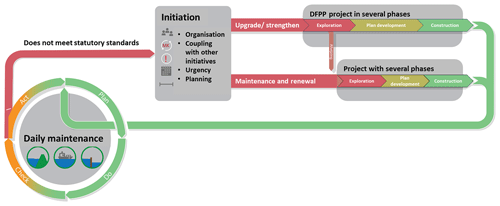
Figure 3The Civil-engineering roadmap highlighting the different steps during the life cycle of a structure in a primary flood defence (INFRAM, 2021).
For each of these steps, we researched via semi-structured interviews and desk study whether there were any points of attention and possible showstoppers leading to a delay in the reinforcement of a civil engineering structure (as well as maintenance (and replacement)). The respondents of the regional water authorities and Rijkswaterstaat indicated that, until now, they did not experience showstoppers. However, points of attention did emerge within each step of the roadmap. The raised concerns were classified by the six critical success factors, as described earlier. This research (INFRAM, 2021) led to several key focus points for each critical success factor, as shown in the Table 2.
Table 2Key focus points for each Critical Success factor with link to step in the Civil-Engineering roadmap (INFRAM, 2021).
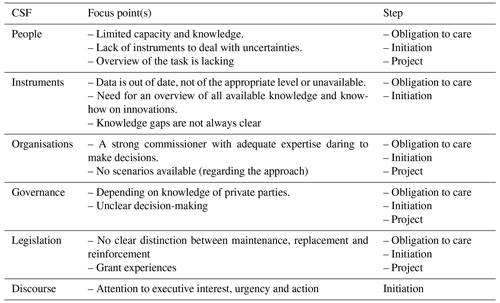
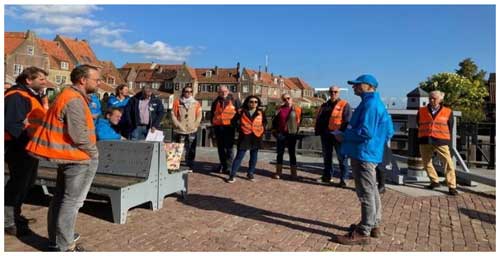
Figure 4Several meetings, held by Hollands Noorderkwartier to transfer and uptake knowledge around seven sluices (Photocredit: Regional Water Authority Hollands Noorderkwartier, 2022).
In several interviews with representatives of the private sector, regional water authorities, Rijkswaterstaat and other governmental organisations, we found that civil-engineering structures still not get the required attention. Often, asset managers are unaware that these structures require a slightly different approach. In Dutch, the word for civil engineering structure is similar to the word that represents paintings and statues. So often a cognitive barrier (Tromp, 2019) occurs, thus hampering the knowledge uptake and transfer. The interviews highlighted that professionals at the water authorities sometimes lack insight in the available knowledge and how to use it. For this purpose, we analysed the available knowledge and highlighted relevant knowledge gaps for further research. We presented the available knowledge using the failure path approach (Tromp et al., 2022a). A failure path is an entire chain of successive events that together lead to a flood according to the definition in the current Water Act. The failure path with the highest probability of occurrence for a specific flood defence structure strongly depends on the design and geometry of the structure and the environment in which it is located. In an in-depth analysis, a distinction is made between the events (i.e. processes of change from one condition to a new, successive condition) that, given a flood situation, may lead to flooding on the one hand, and the condition (based on scenarios) of parts of the flood defence prior to the flood situation on the other.
For the failure paths, we used the four distinctive failure mechanisms used for civil-engineering structures in BOI as input, namely:
-
Reliability of closure process of the structure, probability of non-closure per closure demand;
-
Height of hydraulic structure, probability of excessive wave overtopping and/or overflow;
-
Piping at structure, probability of insufficient resistance to piping;
-
Structural strength and stability, probability of structural failure.
This overview (Tromp et al., 2022a) provides insights where additional knowledge is required and steers the knowledge agendas of the Ministry of Infrastructure and Water Management, Rijkswaterstaat and the research institutes.
The first phase of the `Working jointly together on Civil-engineering structures' project, has provided insights that civil-engineering structures do not yet always get the attention they deserve. This not only affects the stability of the DFPP programme, but also the projects themselves. An update on the scope and number of civil-engineering structures in DFPP is required in the second phase. The regional water authorities need handholds to help them get started with civil engineering structure.
Fortunately, some projects have already been taken up within the DFPP. Regional water authority Hollands Noorderkwartier has worked on the pilot in which seven locks, predominantly have been strengthened in the past years. The knowledge gained has been disseminated in several meetings, but still requires further knowledge transfer to all water authorities having a task (Fig. 4).
In the second phase, allowing knowledge to flow is key. Projects such as those carried out at Regional water authority Hollands Noorderkwartier must actively share their knowledge with similar reinforcement projects on flood defence structure to prevent the traffic lights turning red or orange. The innovation project will make the available knowledge accessible via a knowledge repository, but will also organise frequent meetings, each focusing on a different step and experience of the civil engineering roadmap. A wealth of information and knowledge needs has already been identified from the interviews held. As knowledge is situated and socially constructed, this knowledge must be actively shared and restated after each change in the group of participants. At the same time, a constant awareness of the impact of change on the programme's implementation will be required, as well as additional knowledge. This could also affect how knowledge is shared and absorbed in the future.
No data sets were used in this article.
Conceptualization: ET. Research on Scope of the civil-engineering structures within DFPP: JB and JK. Research on the uniform approach and critical success factors: ET and JA. All authors contributed to the final version of the manuscript and have read and agreed to the published version.
The contact author has declared that none of the authors has any competing interests.
Publisher’s note: Copernicus Publications remains neutral with regard to jurisdictional claims made in the text, published maps, institutional affiliations, or any other geographical representation in this paper. While Copernicus Publications makes every effort to include appropriate place names, the final responsibility lies with the authors.
This article is part of the special issue “ICFM9 – River Basin Disaster Resilience and Sustainability by All”. It is a result of The 9th International Conference on Flood Management, Tsukuba, Japan, 18–22 February 2023.
The authors would like to thank the reviewers for their critical and targeted comments.
This research has been supported by Rijkswaterstaat and the Regional Water Authorities (Dutch Flood Protection Programme).
This paper was edited by Kensuke Naito and reviewed by two anonymous referees.
DFPP: Memo waterkerende kunstwerken binnen het HWBP: een definitie, 2016 (in Dutch).
DFPP: Startnotitie POS Kunstwerken, report, 2018 (in Dutch).
INFRAM: Aandachtspunten Kunstwerkroute (focus point civil-engineering structures roadmap), report, Project number: 21i861, version 2.0, https://publicwiki.deltares.nl/display/HWBPKunstwerken/Over+Samenwerken+aan+Kunstwerken?preview=/292061954/292061962/21.1065099 Rapportage HWBP SK Kunstwerkroute_DEF.pdf (last access: 4 July 2024), 2021 (in Dutch).
IV Infra: Inventarisatie kunstwerkenopgave Samenwerken aan Kunstwerken (Inventory scope civil-engineering structures), Reference INFR210556-R02 Revision: 1, https://publicwiki.deltares.nl/display/HWBPKunstwerken/Over+Samenwerken+aan+Kunstwerken?preview=/292061954/292061960/21.1065130 Rapportage Inventarisatie kunstwerkopgave_rev1.pdf (last access: 4 July 2024), 2021 (in Dutch).
Jorissen, R., Kraaij, E., and Tromp, E.: Dutch flood protection policy and measures based on risk assessment, in: Proceedings of the 3rd European Conference on Flood Risk Management (FLOODrisk 2016), Lyon, France, 17–21 October 2016, https://www.e3s-conferences.org/articles/e3sconf/abs/2016/02/e3sconf_flood2016_20016/e3sconf_flood2016_20016.html (last access: 4 July 2024), 2016.
Most, H., van der Tánczos, I., Bruijn, K. M., and de Wagenaar, D.: New Risk-based standards for flood protection in the Netherlands, in: Proceedings of the 6th International Conference on Flood Management, Sao Paulo, Brazil, 16–18 September 2014, https://www.researchgate.net/publication/266758851_New_risk-based_standards_for_flood_protection_in_the_Netherlands (last access: 4 July 2024), 2014.
Tromp, E.: Enhancing Knowledge Transfer and Uptake in the Design Processes of Flood Defences, PhD Thesis, Delft University of Technology, Delft, the Netherlands, https://doi.org/10.4233/uuid:df56c11b-5366-4720-9f58-015c9bf0316e, 2019.
Tromp, E., Verdijck, N., and Breedeveld, J.: Rode Draad Waterkerende Kunstwerken. Ontwikkeling kennis en kunde voor overstromingskansanalyse waterkerende kunstwerken, version 1.0, Green version, 22 September 2022, https://publicwiki.deltares.nl/display/HWBPKunstwerken/Over+Samenwerken+aan+Kunstwerken?preview=/292061954/292061961/20220920 Eindrapportage Groene versie Rode draad Kunstwerken_v1.pdf (last access: 4 July 2024), 2022a (in Dutch).
Tromp, E., te Nijenhuis, A., and Knoeff, H.: The Dutch Flood Protection Programme: Taking Innovations to the Next Level, Water, 14, 1460, https://doi.org/10.3390/w14091460, 2022b.






